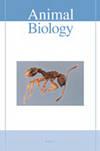Influence of larval nutrition on biological attributes and reproductive performance in Spodoptera frugiperda (Lepidoptera: Noctuidae) under laboratory condition
IF 0.9
4区 生物学
Q2 ZOOLOGY
引用次数: 4
Abstract
An artificial diet and a rearing procedure for the polyphagous pest, Spodoptera frugiperda, were developed to facilitate its culturing under laboratory conditions [27 ± 1°C, 65 ± 5% relative humidity and a photoperiod of 14:10 (L:D) h] throughout the year. The efficiency of the diet was assessed through a comparative study with the natural host of the pest, maize. The biological, reproductive and population parameters of the pest on artificial diet were superior, especially the enhanced mean fecundity of 1796 per female which was more than that of the insect reared on its natural host. The meridic diet gave a higher mean pupal weight (0.217 g/pupa) than the natural diet (0.188 g/pupa). About 81.8% of neonates completed their developmental cycle on artificial diet and emerged as healthy adults, compared to only 57.5% normal adult emergence on the natural diet. On observation, there were 3678 and 3551 eupyrene sperm bundles in the adults emerged from larvae reared on artificial diet and natural diet, respectively. The net reproductive rate () for adults reared on artificial diet was 945.26, it being 703.7 for adults reared on a natural diet. With a sex ratio of 0.55, the biotic potential of S. frugiperda reared on artificial diet was 5.104 × 1028, which is more than that of natural diet (5.740 × 1026). The fertility life table constructed in the present study can play a significant role in predicting population dynamics, which will further help in developing an effective integrated pest management and the developed meridic diet with rearing procedure will be helpful in insecticide resistance monitoring programmes for this folivorous pest.实验室条件下幼虫营养对果夜蛾生物学特性和繁殖性能的影响
开发了一种多食性害虫草地贪夜蛾的人工饲料和饲养程序,以促进其在实验室条件下全年培养[27±1°C,65±5%相对湿度和14:10(L:D)h]。通过与害虫的天然宿主玉米进行比较研究,评估了该日粮的效率。人工饲养的害虫在生物学、繁殖和种群参数方面都很好,尤其是平均每雌1796只的繁殖力比在自然宿主上饲养的害虫高。子午日粮的平均蛹重(0.217g/蛹)高于自然日粮(0.188g/蛹)。约81.8%的新生儿在人工日粮中完成了发育周期,成为健康的成年人,而自然日粮中只有57.5%的正常成年人。经观察,人工日粮和自然日粮饲养的幼虫成虫中分别有3678个和3551个真芘精子束。人工饲养的成年人的净繁殖率()为945.26,自然饲养的成年人为703.7。在性别比为0.55的条件下,人工饲养的草地贪夜蛾的生物潜力为5.104×1028,高于自然饲养的5.740×1026。本研究构建的生育寿命表可以在预测种群动态方面发挥重要作用,这将进一步有助于制定有效的综合害虫管理,而制定的带饲养程序的经向日粮将有助于该叶性害虫的杀虫剂抗性监测计划。
本文章由计算机程序翻译,如有差异,请以英文原文为准。
求助全文
约1分钟内获得全文
求助全文
来源期刊

Animal Biology
生物-动物学
CiteScore
2.10
自引率
0.00%
发文量
34
审稿时长
3 months
期刊介绍:
Animal Biology publishes high quality papers and focuses on integration of the various disciplines within the broad field of zoology. These disciplines include behaviour, developmental biology, ecology, endocrinology, evolutionary biology, genomics, morphology, neurobiology, physiology, systematics and theoretical biology. Purely descriptive papers will not be considered for publication.
Animal Biology is the official journal of the Royal Dutch Zoological Society since its foundation in 1872. The journal was initially called Archives Néerlandaises de Zoologie, which was changed in 1952 to Netherlands Journal of Zoology, the current name was established in 2003.
 求助内容:
求助内容: 应助结果提醒方式:
应助结果提醒方式:


